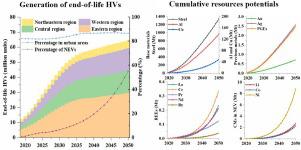Resources, Conservation and Recycling ( IF 13.2 ) Pub Date : 2021-10-23 , DOI: 10.1016/j.resconrec.2021.105979 Ling Zhang 1 , Qingqing Lu 1 , Wei Yuan 1 , Songyan Jiang 2 , Huijun Wu 3

|
China is now boasting a huge number of end-of-life vehicles (ELVs) with a low recovery rate, resulting in a waste of resources and severe environmental pollution. Predicting the generation of ELVs in future helps to enhance recycling efficiency by providing a basis for the planning of recycling industry. However, previous research did not provide a detailed, mid-term forecast. Based on a stocks-driven model and the bottom-up extrapolation of in-use stocks, this study characterizes the generation of end-of-life household vehicles (HVs) in China by addressing the detailed spatial-temporal patterns and resource potentials during 2019–2050. The results show that the annual end-of-life HVs in China will continuously increase during 2019–2050, resulting an accumulated 1.48 billion units, among which urban areas will account for 86%, and internal combustion engine vehicles (ICEVs) will take up 80%. Regarding the spatial patterns, eastern region will possess the largest proportion, and wide variations are found among all provinces due to the difference in population size and economic development level, which have important implications for further planning of end-of-life HVs recycling industry. Before 2050, accumulated quantity of all types of metals in end-of-life HVs will approach domestic mine production (in 2019), or even approach the current global mine production, indicating they have a great potential as an indispensable source for domestic resource supply.



























 京公网安备 11010802027423号
京公网安备 11010802027423号